Monday, July 17, 2006
Family Emergency
Saturday, July 15, 2006
Puerh Taste Off (Week 2 of 5)
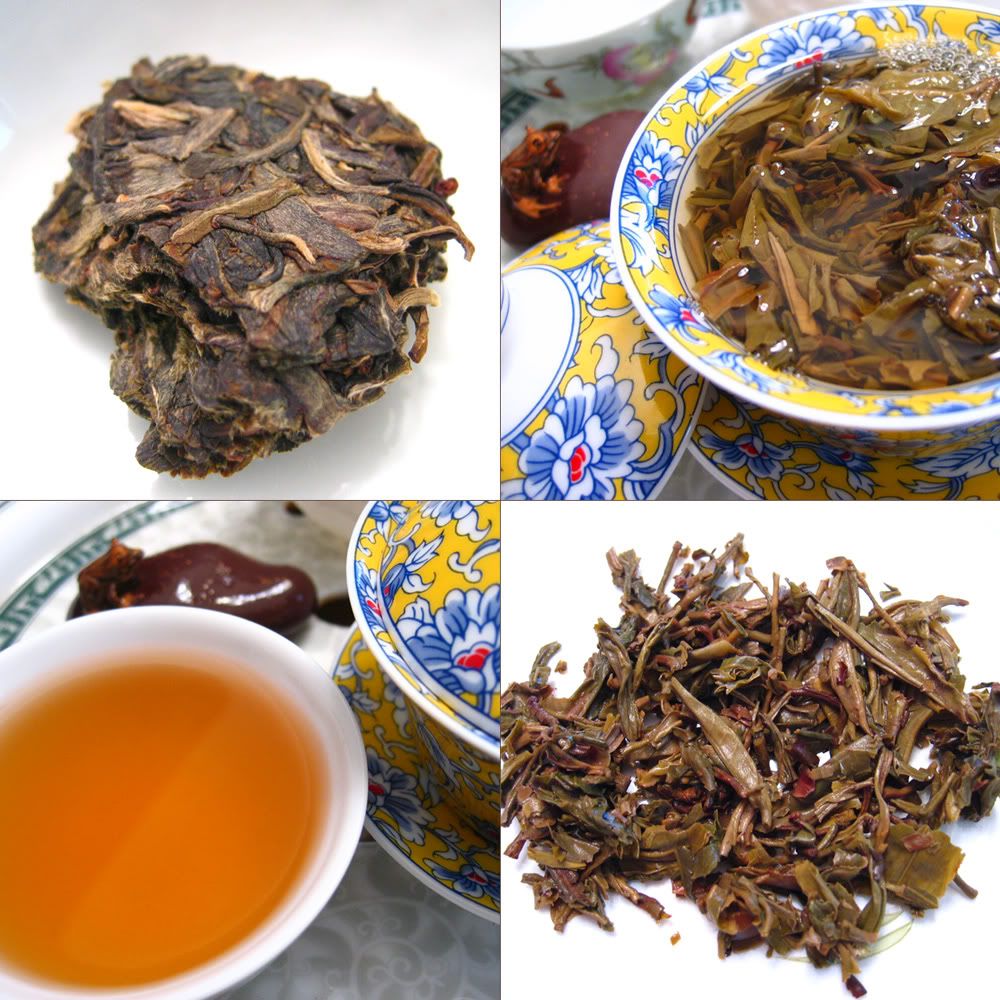 This tasteoff was spearheaded and participated by members of LJ Puerh Community.
This tasteoff was spearheaded and participated by members of LJ Puerh Community.2003 Yunnan Fengqing Tea Factory 12 Zodiacs Raw (mini) Beeng Puerh
Tea courtesy of Marshaln.
I may have treated this puerh incorrectly by brewing it as I would any other young raw puerh. I should have given it longer brewing time from the start, instead of the usual short 5-10 seconds at first infusion. A gaiwan was employed with boiling Crystal Geyser spring water, 30s rinse, 2-3 minutes rest, and then 10s, 10s, 20s – realized that the compressed leaves needed help to loosen in the gaiwan – 10s, 15s, 20s, 1m.
The first 3 brews yielded clear light amber liquor with barely noticeable aromas of grass, apricot and a hint of camphor. After loosening the compressed leaves in the gaiwan and gave it a 10s infusion, the liquor turned into cloudy medium amber. The taste expectedly became more powerful with a bit more camphor in the play and lots of green-ness. The tea is not harsh for such a young cake. Weak cha-qi. Neither particularly exciting nor complex, but it is quite pleasant in the morning with breakfast. Aging capability is questionable at best.
2 stars (mg)
Other participants' tasting notes on LJ Puerh Community are here.
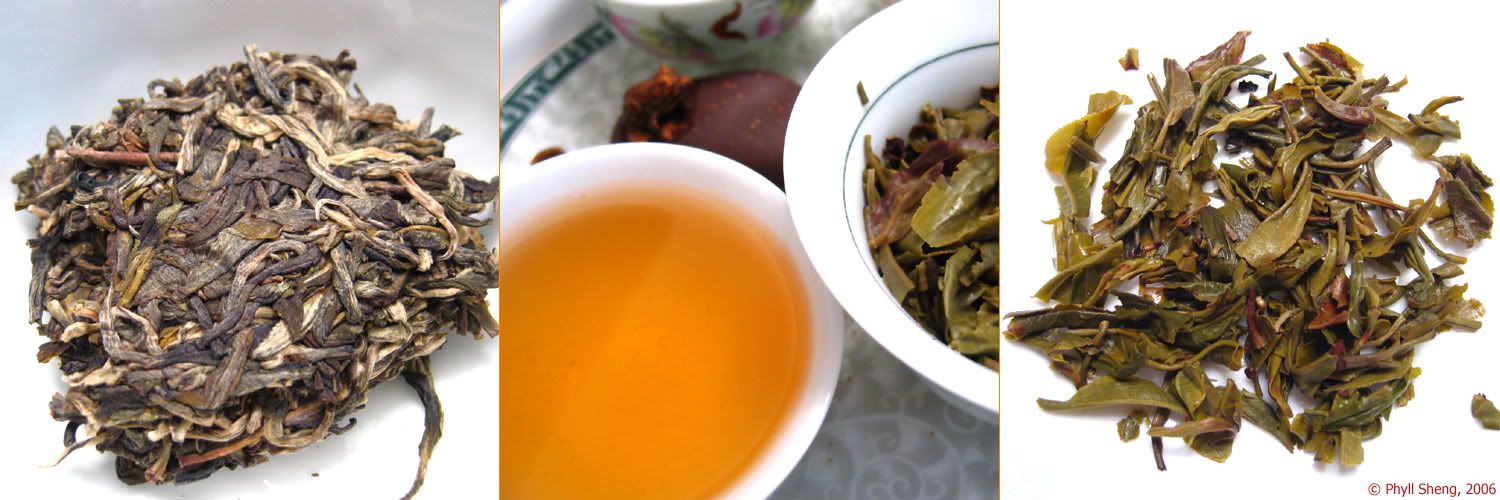
2003 Dadugang Elabora(?) King Tea Biscuit
Tea courtesy of Walt_Park.
This tea was quite pleasant from start (dry form) to the 7th infusion. The dry, compressed leaves was intermixed with dark green, dark brown, and white hairy leaves. It smelled somewhat minty (eucalyptus?) and sweet.
A 4oz gaiwan was used, boiling Crystal Geyser spring water, 20s rinse, 2m rest, and then 10s, 10s, 15s, 15s, 20s, 30s, 45s (rest). The wet leaves had a deep aroma of green forest floor. Slightly sweet smelling, which reminded me of rose wood.
The liquor was light to medium amber in color. Its taste was considerably punchy with bitter gourd-like bitterness. Second infusion was minty, with camphor and slight herbalness. It was cooling in the mouth and had a sweet aftertaste in the back of the throat. The fourth infusion was the most interesting: corn, malt with a pinch of wood and what I thought to be a hint of smoke. Cha qi was quite good. There is no denying that the tea was very young and vegetal throughout. Perhaps it is still too young to be enjoyed casually, but I like its basic qualities.
4 stars (vg)
Other participants' tasting notes on LJ Puerh Community are here.
TN: Sèvre et Maine Muscadet & Costières de Nîmes
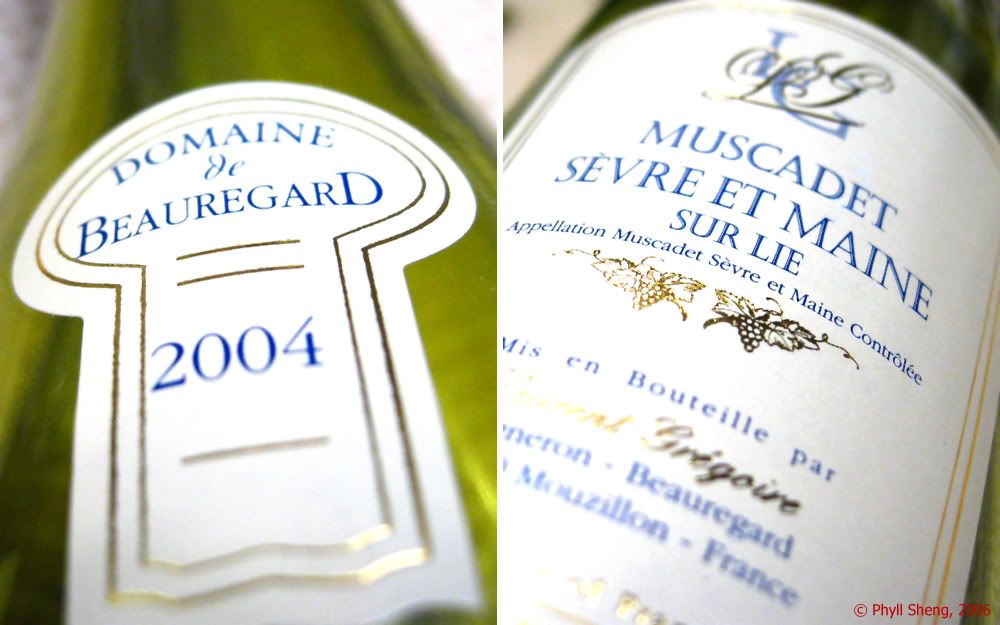 2004 Domaine de Beauregard, Muscadet Sevre et Maine sur lie ($14, 12%)
2004 Domaine de Beauregard, Muscadet Sevre et Maine sur lie ($14, 12%)They say great wines can be had for a bargain. I agree! Unfortunately, this is not one of them. Pale yellow and straw green. Light nose of petrol and alcohol. Nothing much in the mouth...just tart water. Pungent aftertaste, unpleasant. Yech! It seems to be a shadow of what it's supposed to be. I'm pretty sure this was just a bad bottle and not representative of what the wine is supposed to be, given the reputation of the winery and the sur lie style of winemaking. Perhaps it was heat or sun-damaged. This should have been one fine white. Oh well, will someone please buy me another bottle to try?
For more information about the Muscadet Sevre et Maine region and its wines, go to Stratsplace.
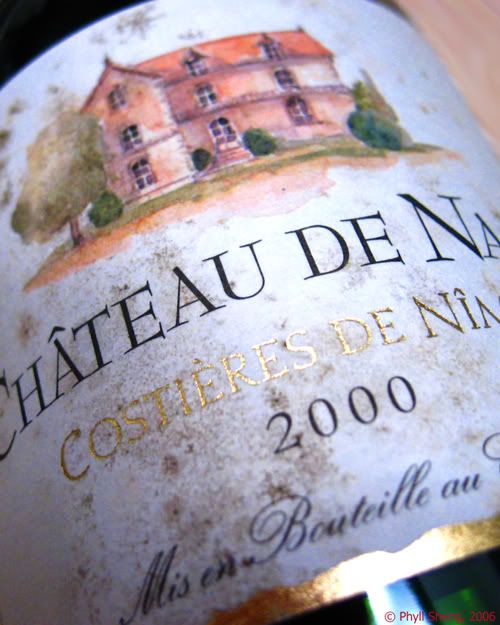 2000 Chateau de Nages, Costières de Nîmes, Rhone Valley ($8, 13.5%)
2000 Chateau de Nages, Costières de Nîmes, Rhone Valley ($8, 13.5%)60% Grenache, 40% Syrah
A casual gift from dear friends, Alex and Christina (thank you!).
Whoa, lots of sediment! I had to use a mesh filter. Massive color! Deep, inky, opaque purple…a “purple hole”. Viscous and thick looking when poured. Nose of dark berries, blueberries, and sour cherries with some dark chocolate and considerable gaminess. Quite oaky and cedary. Extremely dry on the palate. Medium bodied with ripe, puckery sandy tannin. Finishing pretty long with blueberries and coffee. This wine, I believe, can age for at least 2 - 3 more years easily, mellowing out the tannin.
3 stars (good, and very good QPR!)
Note: Costières de Nimes is quite different from any appellation. First of all, because of the uniqueness of Camargue region. The soil is made there of round pebbles. Costières de Nimes predominantly produces red and rosé wine from Carignan grapes primarily and Syrah, Grenache, Cinsault, Mourvèdre and other typical Languedoc grape varieties.
Friday, July 14, 2006
TN: 2004 Giesen Sauvignon Blanc, Marlborough, New Zealand
 Pale yellow. Nose was a bit shy compared to other assertive NZ Sav. Blanc I had in the past. Of gooseberries, cranberries, with steely minerality framing the wine. Explosion of tastes in the mouth with grapefruit and lime coming to mind. A slight effervesence. Refreshing! For $11, you can hardly beat its good value.
Pale yellow. Nose was a bit shy compared to other assertive NZ Sav. Blanc I had in the past. Of gooseberries, cranberries, with steely minerality framing the wine. Explosion of tastes in the mouth with grapefruit and lime coming to mind. A slight effervesence. Refreshing! For $11, you can hardly beat its good value.3- stars (good, but not as satisfying as other more assertive Marlborough examples)
Additional Info:
The Region: Originally known for its production of prime lamb and wool products, Canterbury is now recognized for it's horticultural diversity, including wine growing. The original vines were planted in Akaroa by French settlers in 1840. A resurgence of interest stems from ongoing research conducted at Canterbury's Lincoln University, initiated in 1973.
The Climate: The vineyards of Giesen Wine Estate are situated on the Canterbury Plains, known for its cooler climate due to the closeness of the Southern Alps. In summer the Alps shelter the plains from Westerly rain and foster a constant warm breeze, keeping humidity very low. Long dry autumns, with warm days and cool nights, enable the fruit to ripen slowly with good levels of acidity and extracts.
The Soil: The region's soils are typically silty loams, overlying deep river gravels. The soils are free draining with low to moderate fertility, requiring irrigation in the dry summer months. This results in low yields and explains the great concentration of fruit flavor and extract in our wines.
Additional info from www.dreyfusashby.com/NZ-Giesen.htm
Wednesday, July 12, 2006
TN: Phoenix Mountain Lone Bush Tea (凤凰单丛)
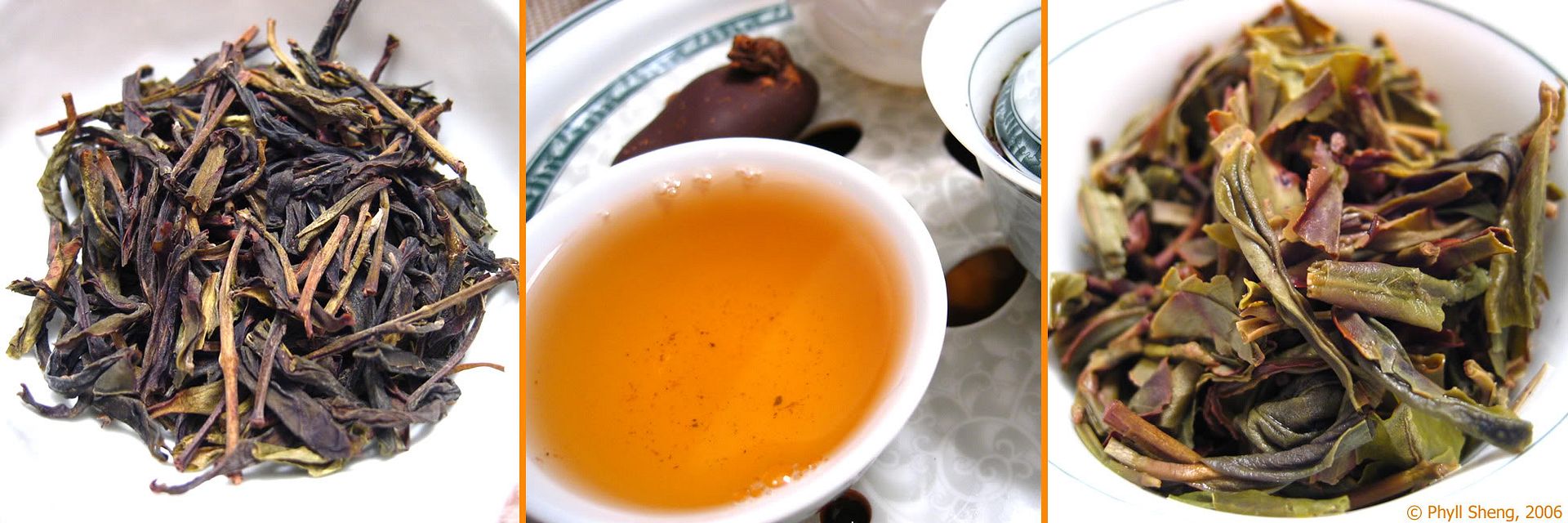 This tea was gifted to me by a relative who got it in Guangzhou in April of 2006. I don't know which harvest vintage this was from. I could ask, I suppose, but for now we'll leave the age detail behind. It looked reasonably fresh.
This tea was gifted to me by a relative who got it in Guangzhou in April of 2006. I don't know which harvest vintage this was from. I could ask, I suppose, but for now we'll leave the age detail behind. It looked reasonably fresh.Dry leaves: Observation could tell that it was a green, unfired Dan Cong. Color ranges from green to oxidized red-black caused by non-uniformity in the degree of oxidation. The long stalks were actually soft, fibrous extensions of the leaves. It smelled slightly sweet (peachy) and an aroma similar to a closet with moth balls, in a good way.
Parameters: This time around I was able to brew the tea better than before, except for the 3rd brew which I did for too long. Using a gaiwan, I filled 1/2 the bowl full of dry leaves. Arrowhead spring water, boiling. Poured high, swift rinse, and then 5s, 5s, 10s, 7s (rest).
Wet leaves: medium to dark green, many with red patches in the middle and on the edges. Beautiful aromas of floral (orchid), honey, peach, and [I swear there was] white pear nose in the background.
Liquor: Clear, medium amber. All of the aromas from the wet leaves were more or less present, though not as concentrated. Minty and cooling. Relaxing. Careful brewing prevented this tea from becoming bitter and tannic (however, I brewed too long for my 3rd infusion...too bitter and tannic. I scaled back the 4th infusion length by 30%). I got tea drunk after the 3rd round. Cha qi was noticeably present and calming. The most amazing part for me was the smell of crème brulee / caramel hiding on the bottom of the empty cup. The finish was long and lasting, with a sweet (caramel?) aftertaste in the very back of the throat. Absolutely nice!
4+ stars (pretty damn good tea in my book!)
Monday, July 10, 2006
TN: Bamboo Green Tea of Mount Emei (峨眉山 竹叶青茶)
 This is one of the teas which I purchased at Wing Hop Fung recently ($6/oz). It's fresh dark-green color when dry, and turns into a beautiful fresh light-green color when brewed. I used a gaiwan and about 80 Celsius spring water, flash rinse, then brewed for 20s, 30s, 45s, 1m (I'm still playing around with brewing time). The resulting liquor was light yellow and straw green in color. It smells and tastes of fragrant rice, barley and green vegetable (spinach comes to mind). Light and refreshing! Very nice!
This is one of the teas which I purchased at Wing Hop Fung recently ($6/oz). It's fresh dark-green color when dry, and turns into a beautiful fresh light-green color when brewed. I used a gaiwan and about 80 Celsius spring water, flash rinse, then brewed for 20s, 30s, 45s, 1m (I'm still playing around with brewing time). The resulting liquor was light yellow and straw green in color. It smells and tastes of fragrant rice, barley and green vegetable (spinach comes to mind). Light and refreshing! Very nice!
Sunday, July 9, 2006
TN: 2005 Delheim Gewurztraminer, S. Africa
 From Simonsberg, Stellenbosch, South Africa ($14)
From Simonsberg, Stellenbosch, South Africa ($14)I think I may have found a new QPR favorite! This gewurztraminer from Stellenbosch was fascinating. Clear yellow-gold. Lychee, honeysuckle, roses and noticeable minerality. Residual sugar (RS) was checked by acidity to lend the wine a semi-sweetness that felt more dry than sweet. Tingling in the mouth (not fizzy). Long 45 sec finish, with mandarin peel aftertaste. Medium-big bodied for a gewurz (14% alc.), yet its brightness and balance between acid, RS, fruitiness gave the wine some airiness.
I brought this bottle along to our favorite sushi restaurant in Studio City, and it was such a perfect match with the sushi and sashimi, and especially with the spicy ginger condiment!
4 stars (vg)
Additional Information from the winery's website.
100% Gewurztraminer grapes from 8 year-old vines. Grapes were harvested with the following analysis:
Sugar: 25ºB
pH: 3.80
Total acidity: 6.37 gram / litre
CELLAR REPORT : Crushing and destemming, followed by mashcooling and skin contact for 6 hours. The juice was left to settle overnight with pectolitic enzymes. Cold fermentation in steel tanks with the aid of selected yeast strains.
BOTTLING DATE : 30 March 2005
RELEASE DATE: April 2005
Going To Wing Hop Fung in Chinatown
 Yesterday afternoon, BBB and I got together and visited Wing Hop Fung in Chinatown. My plan was to see what kinds of spring 2006 oolong they carry and also to get a few ounces of the jasmine tea balls to replenish my dwindling supply at home. Apparently, all the fresh 2006 oolong they have consists of 3 or 4 Taiwanese oolong types and only one kind of Anxi Tieguanyin, as far as I recall. They are all the green qing xiang type. Since I still have a lot of qing xiang TGY at home, I decided to not get any but instead try out their other darker, undated oolongs.
Yesterday afternoon, BBB and I got together and visited Wing Hop Fung in Chinatown. My plan was to see what kinds of spring 2006 oolong they carry and also to get a few ounces of the jasmine tea balls to replenish my dwindling supply at home. Apparently, all the fresh 2006 oolong they have consists of 3 or 4 Taiwanese oolong types and only one kind of Anxi Tieguanyin, as far as I recall. They are all the green qing xiang type. Since I still have a lot of qing xiang TGY at home, I decided to not get any but instead try out their other darker, undated oolongs.As I am a sucker for Dan Cong (a.k.a. Lone Bush), I asked them to brew for us their highest priced Feng Huang Dan Cong “Yellowstone” (@ $68.99/lb). It was one of the mildest tasting Dan Cong I've ever had. While the wet leaves had that typical yellow fruits and slight honey-floral-like smell, it was kind of fuzzy. Was it because they didn't put enough leaves in their Yixing pot? They brew everything using their Yixing pots--which made me wonder if the pots have seen every type of teas the store carries--instead of using a gaiwan. The fact that the tea was served in little paper cups (office-kitchen-water-cooler cups) didn't help matter. I decided to get merely an ounce of this Dan Cong to try properly at home, my way, my style.
We also asked to try the Wuyi Supreme [!] Da Hong Pao and Szechuan Emei Shan "Bamboo Green Tea" (@ $118/lb...still trying to figure out what its Chinese name is). While the Da Hong Pao was supremely dissapointing, the "Bamboo Green Tea" was quite nice. BBB said "Rice-y, grainy, and vegetal," as I recall...he might have said spinach too. Though I liked this tea, I am skeptical with anything served in a sad, little paper cup. I just bought an ounce for a better try out at home. If I like it, I'll come back for more.
Other things I purchased and almost purchased:
- A small, decent quality, thinly-walled, dark zisha Yixing pot (~120ml)
- 4 large(r) porcelain gongfu tea cups
- 3/4 lbs of the jasmine tea balls, but the saleswoman forgot to give the bag to me before I left and it slipped my mind, too.
I must say that I felt slightly uncomfortable with the settings of their tea department because, while I could ask the salesperson to brew any tea before buying, the atmosphere was such that when I asked them, it felt like they were doing me a favor so I should get a kilo of that tea they were about to brew per my request. Further, they have this sloppy, half-hearted way of brewing the tea, after which the saleswoman would say in Chinese “Oh, this is a fresh (Supreme) Da Hong Pao…very good, just came in…how about a pound of this, ok? You and your friend should get this tea, ok?” Oh boy, was I glad I went with BBB as he was able to convince me to be insistent and anticipate the sales pressure.
All this and I haven’t even got into talking about their overpriced cooked pu-erh selections. BBB and I had a good laugh at their $$$$$ 1950’s cooked beeng and what most likely are fake CNNP cooked cakes!
Wing Hop Fung’s tea department is supposedly one of the better stocked tea shops in LA. However, they seriously need serious competition to clean their act up (I’m limiting my comment to their tea department). Maybe competition wouldn't make any difference. This is L.A. after all, not China.
Saturday, July 8, 2006
TN: 2006 Singbulli Estate 1st Flush, Darjeeling
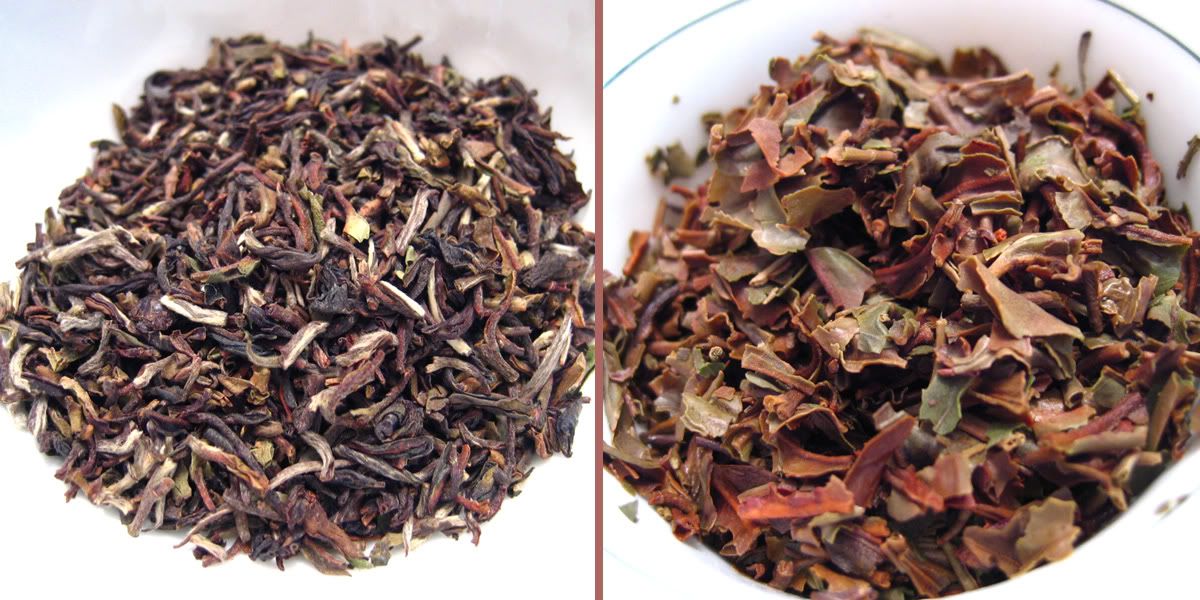 In other short tea news, along with the Gopaldhara noted below I also obtained a Singbulli Estate 2006 1st flush Darjeeling from Chado. This tea was more affordable at $1.75/oz than the Gopaldhara, which was $8/oz.
In other short tea news, along with the Gopaldhara noted below I also obtained a Singbulli Estate 2006 1st flush Darjeeling from Chado. This tea was more affordable at $1.75/oz than the Gopaldhara, which was $8/oz.The leaves are closer to being fannings, with reddish-green-brown broken bits and pieces. I had planned on using this tea for seasoning a whimsical flowery Yixing that I got recently, specifically for Darjeeling. I purchased the pot from Kam of Fun Alliance in Hong Kong.
This morning I decided to brew a bit of it for breakfast to see how it compares to the more expensive Gopaldhara and others I've tried. Surprisingly, it has only a faint 1st flush characteristics and it's closer to tasting like a red tea. Qimen Hung (Red Keemun) comes to mind. The liquor itself is red-brown in color. Slightly smoky, medium bodied, with a touch of citrus. Like the Gopaldhara, it's not biting with tannin. Is this really 1st flush, I wonder? Overall, a simple yet decent everyday tea.
2 stars (moderately good) an inexpensive good tea with breakfast.
TN: 2006 Gopaldhara Estate Spring 1st Flush Darjeeling

Inspired by Toki's tasting of the 2006 Gopaldhara Estate 1st flush Darjeeling, I went to Chado Tea Room yesterday afternoon to buy 2 ounces (@ $8/oz) of this tea to do a tasting comparison. I'm not sure if what I got was the same type and grade as the one Toki tasted. An estate usually produces more than one class of 1st flush Darjeeling hailing from different farms and altitudes.
At the offline last weekend, the manager of Chado gave us a complimentary pot of this Darjeeling. I remember it to be charming, aromatic, tasty and smooth. While I thought the Makaibari 1st flush that I had a couple of months ago was more aromatic, this Gopaldhara was certainly much smoother and approachable.
Brewing method: 120ml gaiwan, 1/2 full dry leaves, boiling water, flash rinse, and then 8s, 10s, 10s, 15s, and 2m.
The dry leaves were considerably small, some with lots of white hair. Color ranges from green with red edges to brownish and black. It smelled of yellow fruits, sea breeze, dried flowers and a bit green. The heated (but dry) leaves in the gaiwan reminded me of Granny Smith apple (?), citrus, and apricot. The smell of the wet leaves was much mellower and fresh, however, than when it's dry: of muscat, honey, peach, plums, and a hint of straw green. Interesting!
The liquor is of medium amber color. The immediate effect of drinking this was a refreshing and relaxing feeling. It was fruity, floral and pleasantly grassy. It had a smooth and an almost creamy texture to it, and it finishes quite dry. In the end, it left a sweet aftertaste.
Brews well for only 3 rounds, after which the tea lacked the abovementioned aromas and taste.
4 stars (vg) a complex, layered, and tasty black tea.
Friday, July 7, 2006
Puerh Taste Off (Week 1 of 5)
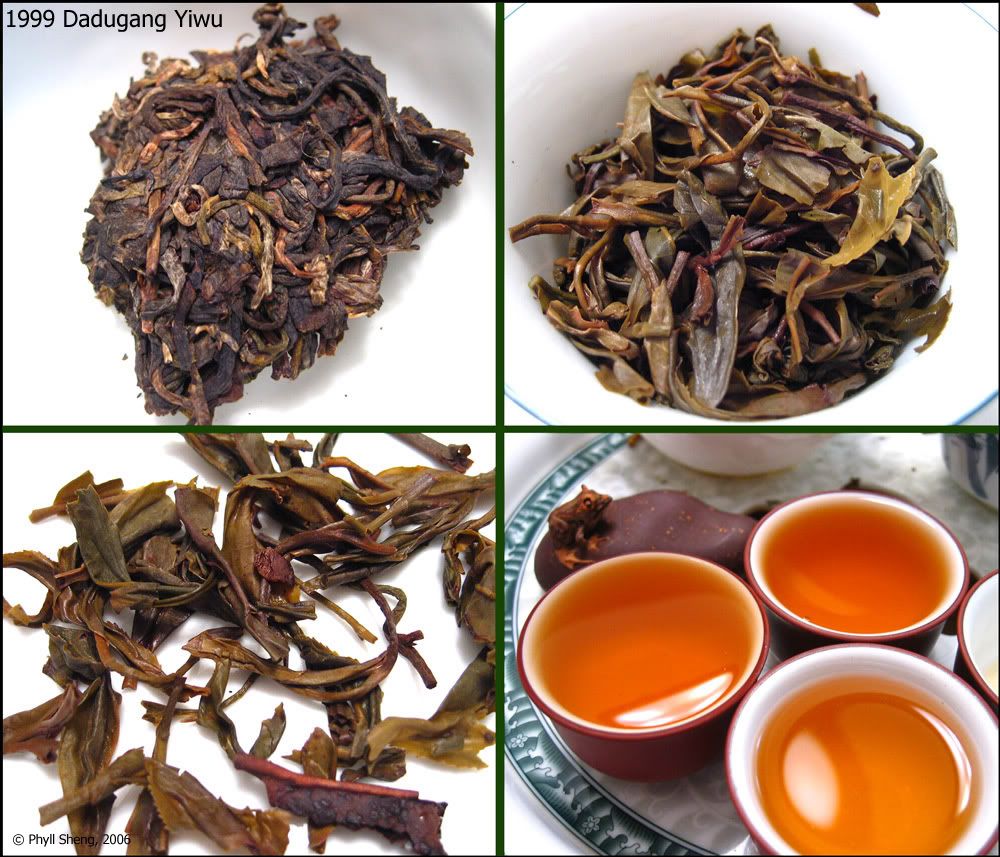 1999 Dadugang Yiwu Beeng Puerh
1999 Dadugang Yiwu Beeng PuerhThanks to psychopuncture for providing this tea to the LJ Pu-erh Community Pu-erh taste off!
Dry leaves: Many stalks (?) and leaves of medium-length which are long and thinly rolled. Color ranges from greyish dark green with noticeable white hairs to deep dark browns and black. Looks appropriately aged for a 7 year old tea. Hardly any smell, except for some faint salty/sweet plum-y aroma.
Brewing parameters: 150ml gaiwan, boiling multi-filtered water, 20s wash, 2m rest, then 8s, 10s, 15s, 30s, 45s, 1m.
Wet leaves: It smelled salty and sweet at the same time. It reminded me of preserved yellow plums and bamboo. Most of the dry “stalks” turned out to be long fibrous extensions of the leaves.
Liquor was generally yellow to medium brown in color, though slightly unclear from 1st to 6th (last brew). It poured with considerable viscosity. From the first cup onwards, the tea lacked complexity and characters. Brew after brew came out pretty much the same, except: the first brew was more medicinal (ginseng?) and the 4th brew had a bit of camphor in the aftertaste. Otherwise, the tea had a noticeable saltiness with plum, bamboo, and a faint sweetness. The aftertaste was minty and cooling. Light bodied, and hollow in the mid palate (like a doughnut's hole) . Cha chi was unsatisfactorily on the weak side.
1 star (not good but not bad)
Click here for other participants' opinion.
Note: the other tea for this week's taste off is the 1999 Mangshi Tea Factory from Dehong County, Yunnan.
Tuesday, July 4, 2006
TN: 2005 Spring Great Red Robe (大红袍) Wuyi Oolong
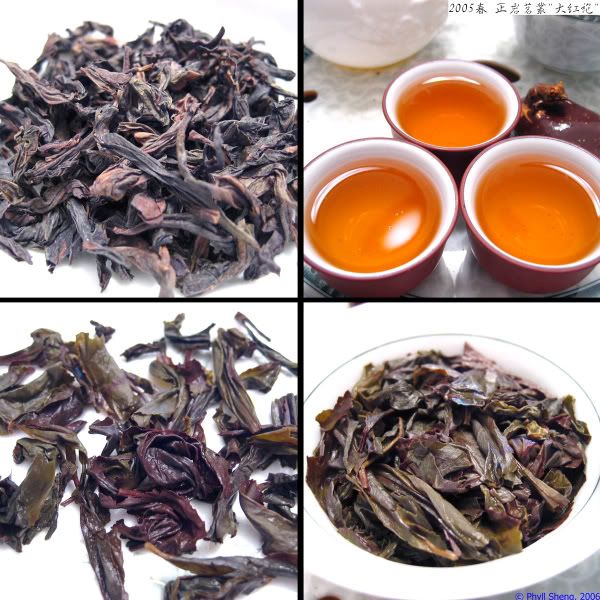 From: Hou De Asian Art for $20.50, 2 ounces.
From: Hou De Asian Art for $20.50, 2 ounces.Brewing method: gaiwan, dry leaves 3/4 full, 100/99 celsius multi-filtered water, flash rinse, and then 7s, 7s, 14s, 20s, 40s, 1.5m, 2.5m.
Dry leaves: long whole leaves, a few are broken. Color ranges from medium brown to charcoal grey. Nose of deep roast with just a slight fruitiness and floral in the background, masked by the roast.
Cha chi: noticable, though somewhat mellow. Calming.
First infusion (7s) had deep roast dominatig the scene and barely anything else in the tea. Second infusion (7s) was noticably more astringent and high toned with the fruity and floral characteristics coming forward a bit, but still overwhelmed by the burnt nose. Third (14s) gave the most complexity with its creamy and smooth feel and fruit and floral coming out better...minty and cooling in the mouth. Fourth (20s) gave a minty and freshening tea, but tasted lighter already, except for the persistent burnt nose. Fifth (40s) light and sweet tasting...dying out. Sixth (1.5m) just the burnt nose. And finally, seventh (2.5m) a glorified colored water with some tea taste. The overall finish from 1st to last infusion was short.
Vendor said: This tea "[H]as an amazing ripe fruity fragrance and changes to delicate floral aroma when cools. Medium-bodied. With flavors of honey, ripe apples, lychees, and later orchid/roses. Not spicy but assertive, mature and round."
I said: Where are you honey, ripe apples, lychess, and roses? Come out and play! No....?
3- stars (good but slightly dissapointing)
An Offline With "bearsbearsbears" and "MarshalN"
After a few sips of wine, cooled down and relaxed, the both of us met Marshaln outside of Chado Tea Room at the appointed time to begin the tea fun. I brought along my tea set, which included 2 gaiwans, a fairness cup, and 6 gongfu yixing cups among others. Setting these apparatus up invited some “curious” looks from the manager and the staffs. You see, they are more accustomed to customers drinking their tea…ummm…differently (I don't want to sound snobbish by saying “outta polka-dotted teapots,” which is totally fine by me!). We invited the manager to taste with us, which he gladly accepted and joined us for a few rounds, although he dropped out midway for unknown reason (tea drunk?).
MarshalN brought along with him his stash of Da Hong Pao (@ $300/lb), which was very pleasant, mellow, fruity, floral and quite complex, imho. BBB brought along a sample of 1997 Xi-Zhi Hao "Yi Wu Zheng Shan Wild Big-Tree," (@ $145/357gr beeng) which was a bit simple and light for a brand that is supposed to be, to quote the vendor: "The very premium Pu-erh series that has a rich historical background and ranked No. 1 of several selected 2005 pu-erhs by Asian T4U forum members!" Perhaps we didn't use hot enough water. I brought with me the 2005 Chang Tai Yiwu "Pure Ancient Tree" beeng (@ ~ $7/100gr beeng), which my fellow tea mates found reasonably pleasant, I believe, for a young tea, though not overly complex either.
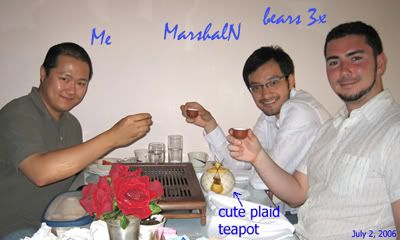
We had a flowing and lively conversation and I learned a lot about tea and non-tea things from them. After 2.5 hours, unfortunately, we had to part way because MarshalN had a flight to catch (I later learned he almost missed). As a token of our newfound friendships, I gifted BBB a bottle of 2002 York Creek Port, Spring Mtn., Napa Valley and MarshalN a 2003 Ridge Lytton Springs Zinfandel, both of which are my heavy favorites.
I enjoyed the offline tremendously, and was very happy to have met them in person! I look forward to the day we could meet again and also to meet other tea friends.
Sunday, July 2, 2006
A Conversation About Pesticide Use in Tea Producing Areas in China
"[T]he over-use of pesticide in tea shrub planting is a common problem on many tea plantations. Even if it is true that “the older the better”, what is the point of storing for ages a raw brick which might have come from a plantation where pesticides have been over-used? And how can Puer tea enter the world market successfully?" 1
1 Thai-Yunnan Project Bulletin 2006, "Why YIWU : A Puer Tea Home Town in Southwest China" by Kathy Zhang, The Australian National University
Saturday, July 1, 2006
TN: 2003 M. Chapoutier "La Bernardine", Chateauneuf-du-Pape
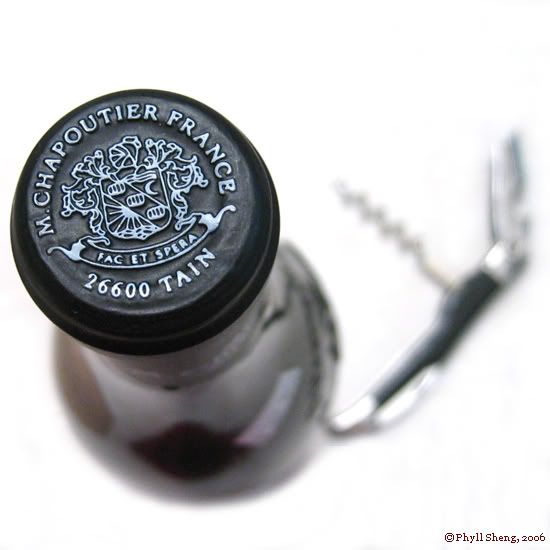 [$40/750ml, 14.5% Alc.]
[$40/750ml, 14.5% Alc.]100% Grenache.
Soil / Terroir: Quaternary terrace, with a surface of rolled stones coming from the former bed of the Rhône.
Harvesting: The grapes are carefully selected during the harvest ; this selection is compulsory for the wine to be given the Appellation.
Vinification: In vats made of concrete covered with exposy resin, because grenache is very sensitive to oxydation. The grapes are 100% destemmed before being placed in vats. Fermentation lasts from 15 days to 3 weeks at a temperature which does not exceed 32°C.
Maturation: In oak barrels and vats for 12 to 15 months.
TN: First glass out of the bottle (the rest being decanted). Clear and penetrating ruby red color. One sniff and I was very happy! I'm getting focused dark fruits, definitely plums there, and then it's smokey, gamey, barnyard (good way) and a bit oak vanilla. I also detected some coffee nose there (Java or Sumatra?). Full bodied with bright lively acidity. Blueberries emerges in the mouth. The acid was a plus, considering how hot the 2003 growing weather was all around France and Europe. Still very tight and tannic being fresh out of the bottle. Somewhat spicy and hot finish. 40 sec finish.
After 2.5 hours in the decanter: the wine turns fruitier than before. Perdominantly blueberries and plums, framed with oak and a hint of vanilla. There is a bit of gamey-ness left, but it has somewhat dissipated. Coffee and liquirice are present. Still tight and the tannin somewhat coarse. I believe this wine has a long bottle life ahead, albeit the alcohol is a bit hot in the back.
10 hours in the decanter: of cherries, red fruits and violet. Tannin was still unrelentlessly tight and puckery, no sign of mellowing out.
3+ stars (g - vg)
An Academia Essay on The Town of Yiwu in Yunnan
The above is not my own recent epiphany. It was meant to be a leading introduction (maybe a lame one at that) to an excellent essay written by Ms. Kathy Zhang of the Australian National University’s Research School of Pacific & Asian Studies (Anthropology Faculty). Her insightful essay is the kind of material that help quench my thirst for tea knowledge. Unfortunately for me, my pursuit of wine and tea knowledge has to be mostly done indirectly. I am a bystander, a spectator, a mere consumer – though an educated one at that, at least I'd like to think so – of information, if you will. Whatever I understand about pu-erh and Chinese tea cultivation, I owe it to people like Ms. Zhang as well as a horde of tea enthusiasts who are the backbone of various discussion fora.
Enough said. Here is the article.
Note: Thank you to kibi_kibi for finding and sharing this article on Livejournal Pu-erh Community, in which a healthy (if somewhat heated) discussion was born out of Ms. Zhang’s article.